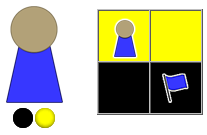The script on this page shows the implementation of simulated agents playing the negotiation game Colored Trails. These agents differ in their ability to make use of theory of mind, the human ability that allows us to reason about what other people know and believe. The controls for this script are explained at the bottom of this page.
Colored Trails

|
| Figure 1: In this example, the blue player starts in the top left corner and wants to reach the bottom right corner. |
Colored Trails is a negotiation game played on a board with tiles of different colors (see also the Colored Trails homepage). There are many different ways to play Colored Trails. The way we describe here is just one possibility. In our setup, three players each receive a set of chips that allows them to move around across the board. Players can move horizontally and vertically to a tile next to their current location, but only if they hand in a chip of the same color as their destination tile. For example, the blue player in Figure 1 can move down by handing in a black chip. However, this means that the blue player will no longer have a black chip to reach his goal in the bottom right. Instead, the player can move right first by handing in a yellow chip. This way, he can still use the black chip to reach his goal location.
Each player receives four chips at the beginning of the game, randomly drawn from one of the colors on the board. This means that a player may not end up with the chips he needs to reach his goal location. To help players to reach their goals, players can negotiate over ownership of the chips. In out setup, the blue player and the green player are allocators, who simultaneously make an offer to trade some of their own chips for the chips owned by the red player. The red player, also called the responder, then decides to accept one of these offers, or to reject both offers. If the responder accepts an offer, the exchange of chips is carried out. In either case, the negotiation ends and the players move as close as possible to their goal, given the set of chips they own.
Each player is scored based on how closely he ends up to his goal location, indicated by a flag on the board. The scores are listed in the table below.
| Situation | Change in score |
|---|---|
| Ending on your goal location | +50 points |
| Ending anywhere but your goal location | -10 points per step towards your goal location |
| Ending with unused chips | +5 points per chip |
As the table shows, players get the most points for reaching their goal, although every step in the right direction helps. Also, even if you cannot use a chip to reach your goal location, it is worth a few points. After the negotiation, the game automatically gives the players the highest possible scores given their chips.
At the start of the game, each player is placed at the center of the board and receives a random goal location, which is at least three steps away from the center. Also, players always have different goals. Players know the goal locations of each of the agents. That is, allocators know the goal of the responder, as well as of their competing allocator.
